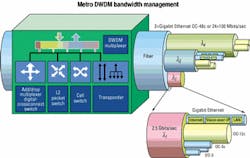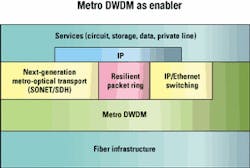New management for the metro
Efficient metro bandwidth management lowers network operation costs while enabling new services.
TEJAS R. VASHI, Cisco SystemsToday's metropolitan-area transport is the stress point of the entire public telecommunications network. The Internet and other forms of data communication continue to drive residential and business demand for higher bandwidth access. At the same time, capacity has risen rapidly in the interexchange carrier core, furthering the trend toward multiregional data networking. Caught in the middle, metropolitan-area-transport network providers are being forced to catch up quickly with the mushrooming demand for data bandwidth, while still maintaining quality in traditional voice services.
Metro service providers need solutions that enable them to increase the bandwidth they have available and manage that bandwidth cost-efficiently. For incumbent local-exchange carriers and competitive access providers alike, the key to the viability of new metro transport solutions is fast return-on-investment (ROI) through lower costs and new sources of revenue. Therefore, solutions must enable service providers to increase the density of services they can offer and respond quickly to market demand for new services.
The two most effective ways of meeting the metro bandwidth crunch are by increasing capacity with DWDM and by increasing TDM efficiency with next-generation transport platforms. These two methods have advantages individually-but when used in combination, they can radically enhance the economics of metro transport investment. Together, DWDM and next-generation transport can cut incremental service costs by up to 80%, shortening ROI periods to as little as three months.
In addition, metro DWDM and next-generation transport solutions leverage existing infrastructure; provide flexible interfaces for TDM and data; save space and power; rescale for future increases in demand; and help simplify operations, administration, management, and provisioning (OAM&P). All of these factors mean that service providers can successfully break through the metro transport bottleneck to achieve new levels of capacity and more profitable bandwidth management.
In today's telecommunications market, digital applications are driving the need for greater bandwidth delivery to both commercial and residential customers. While the Internet leads the list of drivers for data demand, other important applications include virtual private networks, data warehousing, voice-over-IP, videoconferencing, and video on demand. As demand for bandwidth-hungry applications increases, so do the bandwidth needs of residential and business access. Asymmetric DSL and cable-modem broadband services are on the rise.
At the same time, business networking increasingly demands 10- and 100-Mbit/sec and Gigabit Ethernet services, as well as TDM services such as DS-1 (1.55-Mbit/sec), DS-3 (45-Mbit/sec), and even OC-3 (155-Mbit/sec) delivery. The greater competition in recent years among metro service providers has fueled the demand for high-speed access by lowering price points and increasing the range of available service offerings, including non-TDM services directly targeted at high-volume customers.
While the vast majority of voice traffic remains local, data is routinely accessed from anywhere in the world so that only a small percentage of transfers stay within the local exchange. Since servers can be located in houses and small offices that are outside of commercial areas, high-bandwidth usage may occur at virtually any point in the network. Caching centers and content networking allow Internet hosting services to be distributed to metropolitan areas, offloading demand from the core and putting more bandwidth pressure on metro networks.
The result of all these market trends is that the weak link in the public network has become the metropolitan transport area. A decade or more ago, when the architecture of today's metro network was being designed, a major concern was to change over to a reliable all-digital network based on SONET transport. Since the traffic at that time was predominantly voice, the formulas used then to determine bandwidth per customer are too constrictive by today's usage patterns.
A typical metro network may have deployed OC-3 and OC-12 (622-Mbit/ sec) access rings leading to an OC-48 (2.5-Gbit/sec) backbone ring. According to traffic predictions made before the Internet boom, this level of deployment was considered sufficient to provide excellent capacity and room for growth. Now, all of these rings need to be vastly rescaled in order to meet the growing traffic demands of today-not to mention those of the future.
Service providers are evaluating various options for meeting the increased demand for data services. The first is to attempt to drive data transport over existing legacy TDM infrastructures. While that may work for small data service requirements, traditional TDM networks soon fall short, as they were never designed to scale accordingly. More than three quarters of a DS-3, for example, is wasted when leased as a dedicated 10-Mbit/sec Ethernet pipe. The same holds true for a third of an OC-3 leased for 100-Mbit/sec Ethernet. Therefore, equipment and network scalability, along with network provisioning and maintenance costs, make this scenario too cost-prohibitive.
A different option is changing the entire network by adding fiber and introducing new add/drop multiplexers (ADMs) and transport platforms that have greater TDM capacity. Obviously, this proposition is prohibitively expensive in most cases, especially when it involves laying new fiber. It is a shortsighted approach, as well, unless it allows for rescaling capacity in the future, when bandwidth demands will have grown to even higher levels.
A less radical approach is to overlay the TDM switched voice network with a routed data network. This option may require additional fiber installation, depending on the implementation. It also requires side-by-side equipment that takes up valuable space in central offices, as well as much more complicated OAM&P for the two overlaid networks.
All of these options have drawbacks in terms of capacity and expense. The best solution is one that increases overall capacity and manages bandwidth more efficiently, while requiring the least additional investment in infrastructure. A combination of DWDM and next-generation transport provides this solution. Metro service providers are already looking for solutions that not only combine these capabilities, but also optimize them for metro-area requirements.
DWDM technology multiplies the total bandwidth of a single fiber by carrying separate signals on different wavelengths of light. DWDM is already a familiar technology in long-haul core networks, where it has been used successfully for several years to vastly increase the capacity of long-haul fibers. Metro networks stand to realize the same benefit: with DWDM, a fiber that now carries a single OC-48 stream can carry a dozen or more equivalent wavelengths. What is now a one-lane road turns into a multilane superhighway.But metro DWDM has to be designed differently from long-haul DWDM. For interexchange applications, DWDM systems have to handle the attenuation and signal loss inherent in connections over hundreds of kilometers. In metro applications, though, where distances are measured in tens of kilometers at the most, attenuation is not the primary challenge.
Unlike point-to-point intercity connections, metro rings have many add and drop points that serve as on-ramps to the network. So metro DWDM systems have to be designed to provide the flexibility for adding and dropping individual wavelengths at different access points in the network, while passing along the wavelengths that are not needed at those points.
Adding wavelengths, or lambdas, enlarges the pipe, but it is important to use the extra capacity efficiently as well. Next-generation metro transport platforms provide the versatility needed to groom smaller services efficiently onto each wavelength. Next-generation platforms have appeared that can handle traditional DS-1 and DS-3 services, 10/100-Mbit/sec and Gigabit Ethernet services, and interfaces to TDM transport that scale from DS-1 to OC-192 (10 Gbits/sec). In combination with metro DWDM technology, these systems give carriers the capability of scaling service offerings over a wide range, including:
- Wavelength services for large customers with need for applications like storage-area networking, which re quires a huge pipe for frequent backups. In these cases, an entire wavelength may be composed of a line-rate Gigabit Ethernet signal or one of several other interfaces, including Fibre Channel, Escon, Ficon, D1 video, etc.
- Subwavelength services that guarantee full line rate for a portion of a wavelength at any time. Next-generation systems support transport for any data, TDM, or combination of services on any wavelength, eliminating the wasted bandwidth inherent in legacy systems.
- Subwavelength services that are statistically multiplexed, allowing the provider to oversubscribe the connection in order to maximize usage based upon demand, as well as time-of-day traffic requirements. For example, a service may be used heavily for commercial traffic during the day and for residential traffic during the evening, though it could not handle the full level of both types of traffic simultaneously.
Figure 1 shows the aggregation of these various types of services on a DWDM fiber. Figure 2 illustrates the varied layering of transport and service protocols that is possible on top of DWDM wavelengths.
By enabling such a wide range of service offerings, DWDM plus next-generation metro transport ad dresses the overriding concerns of service density and velocity. Greater capacity and efficiency enable carriers to approach the maximum service density-that is, the greatest total number of services that can be provided on each wavelength of the fiber. High-service density means the greatest number of customers is served by a given investment in network infrastructure.At the same time, carriers can achieve higher service velocity in a competitive marketplace. With maximum bandwidth available and flexible bandwidth management, carriers can introduce new services and modify existing ones more quickly-then they can make service alternatives available faster to a wider range of customers.
New solutions are emerging that show the advantages of DWDM used in combination with next-generation metro transport. Previous-generation optical ADM (OADM) filters, for instance, typically required half of a seven-foot bay or more in space and were designed to add/drop four or more wavelengths simultaneously at any given spot.
Today, next-generation OADM filters are appearing that enable add/dropping wavelengths individually or in pairs and only require a single rack unit (1.75 inches) of space. These new OADM filters make it viable in space and cost to deliver individual wavelengths to access points in office buildings, campuses, apart ment complexes, and neighborhoods.
No less remarkable are the next-generation transport platforms that map services to individual wavelengths. Some solutions allow up to eighteen wavelengths to be demultiplexed, groomed, and remultiplexed in transponder units that, together with the OADMs, need less than a single bay in space. Single cards provide individual or multiport interfaces for DS-1, DS-3, 10/100 Mbits/sec and Gigabit Ethernet, OC-3, OC-12, OC-48 and OC-192.The same platform can be populated with the appropriate shelves and cards and used at any point in the metro network-helping to simplify purchasing, installation, and upgrades while keeping inventories to a minimum. International Telecommunications Union (ITU)-grid compliance enables these new platforms to be used together with older network elements on the same ring. Figure 3 shows the flexibility of the new DWDM and next-generation transport systems in metro areas.
Comparing DWDM and next-generation metro-optical transport with previously available systems demonstrates the radical economics that result from the new solutions. The new solutions leverage existing infrastructure to provide many times the bandwidth previously available on a fiber pair. The systems consume about one-eighth the power per service of older equipment and reduce the floor and rack space used by approximately 75%.
As a result of these factors, the cost per incremental service drops to only 20% of that of previous systems. This reduction can save millions of dollars in annual operating costs and make it possible to recoup ROI for many applications within a single quarter, instead of a year or longer.
While costs and profits are the bottom line, other factors are important as well. DWDM and next-generation transport allow metro service providers to position themselves better for future developments in the industry. The new solutions can be scaled up to OC-48 and even OC-192 on each wavelength, and new wavelengths can be added as network demand increases.
Unified platforms make OAM&P easier, cutting costs and speeding up response to customers. The greater service density and velocity that result will prove essential as more high-bandwidth services, such as video applications, come online.
Service quality can improve as well. With more bandwidth available and efficiently managed, carriers can provide dedicated bandwidth to more customers. Those who will benefit include not only large enterprises with extensive private networks, but also customers who need guaranteed delivery to support real-time applications, such as videoconferences. At the same time, greater overall capacity will make available more statistically multiplexed bandwidth for cost-efficiency where dedicated bandwidth is not essential.
Finally, SONET will continue to exist with DWDM, providing proven reliability for traditional voice services.
MAN service providers are faced with the challenge of providing greater bandwidth for tomorrow while containing costs today. DWDM and next-generation transport platforms pack the double punch of increased capacity and improved efficiency, making these systems the right solution for growth and profitability.
The new systems multiply capacity on existing fiber and provide greater flexibility for handling both TDM and data services. Service providers can cut costs and open up new sources of revenue that will yield a rapid ROI.
Tejas R. Vashi is manager, market development, for the optical transport business unit at Cisco Systems (San Jose, CA). He can be reached via the company's Website, www.cisco.com.




